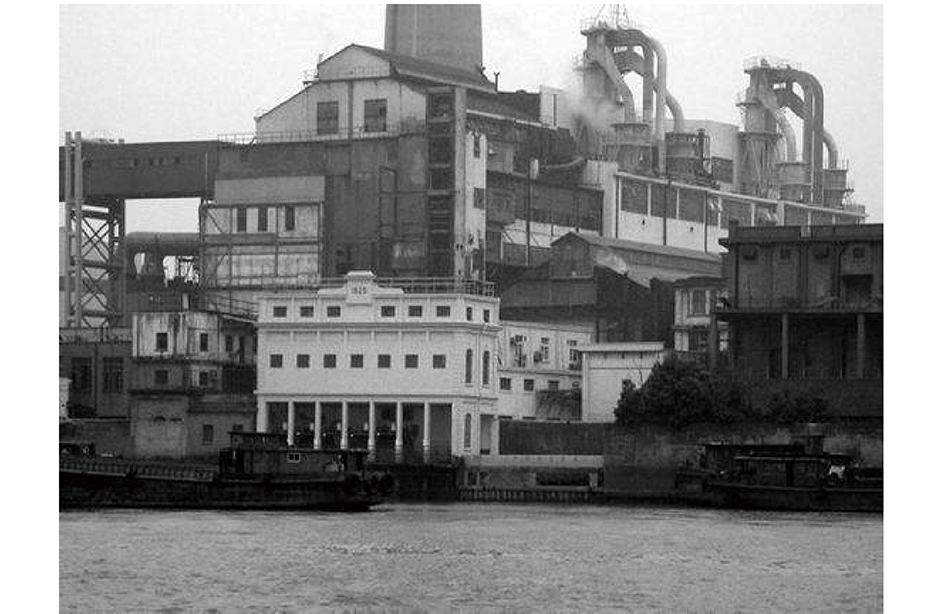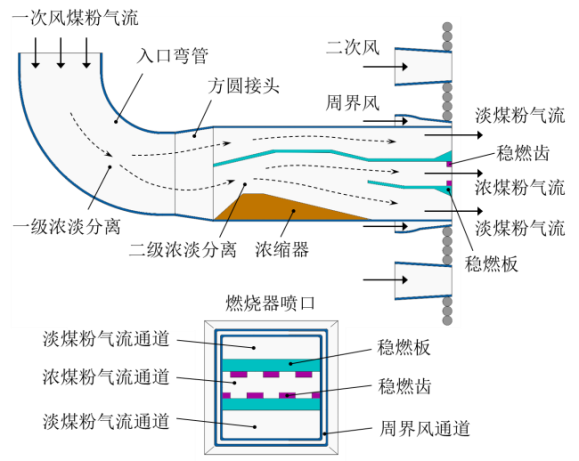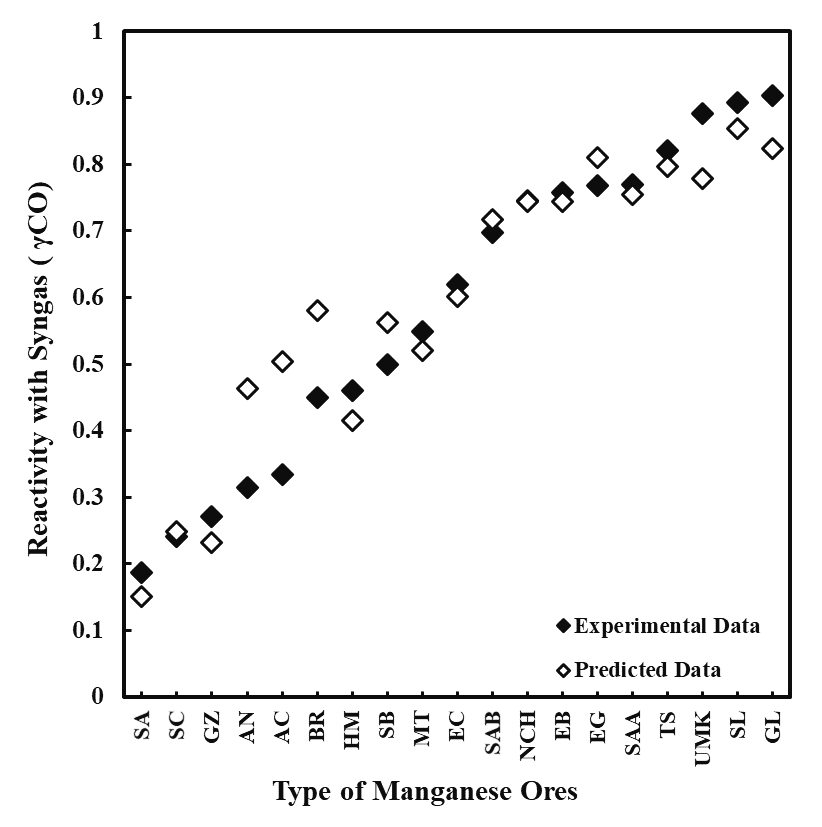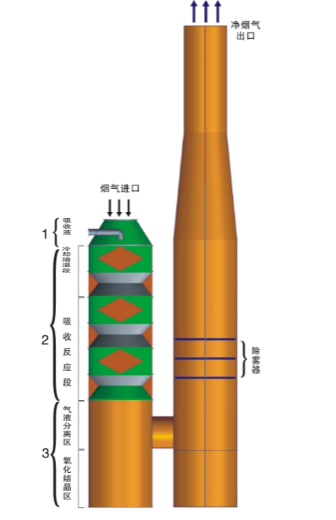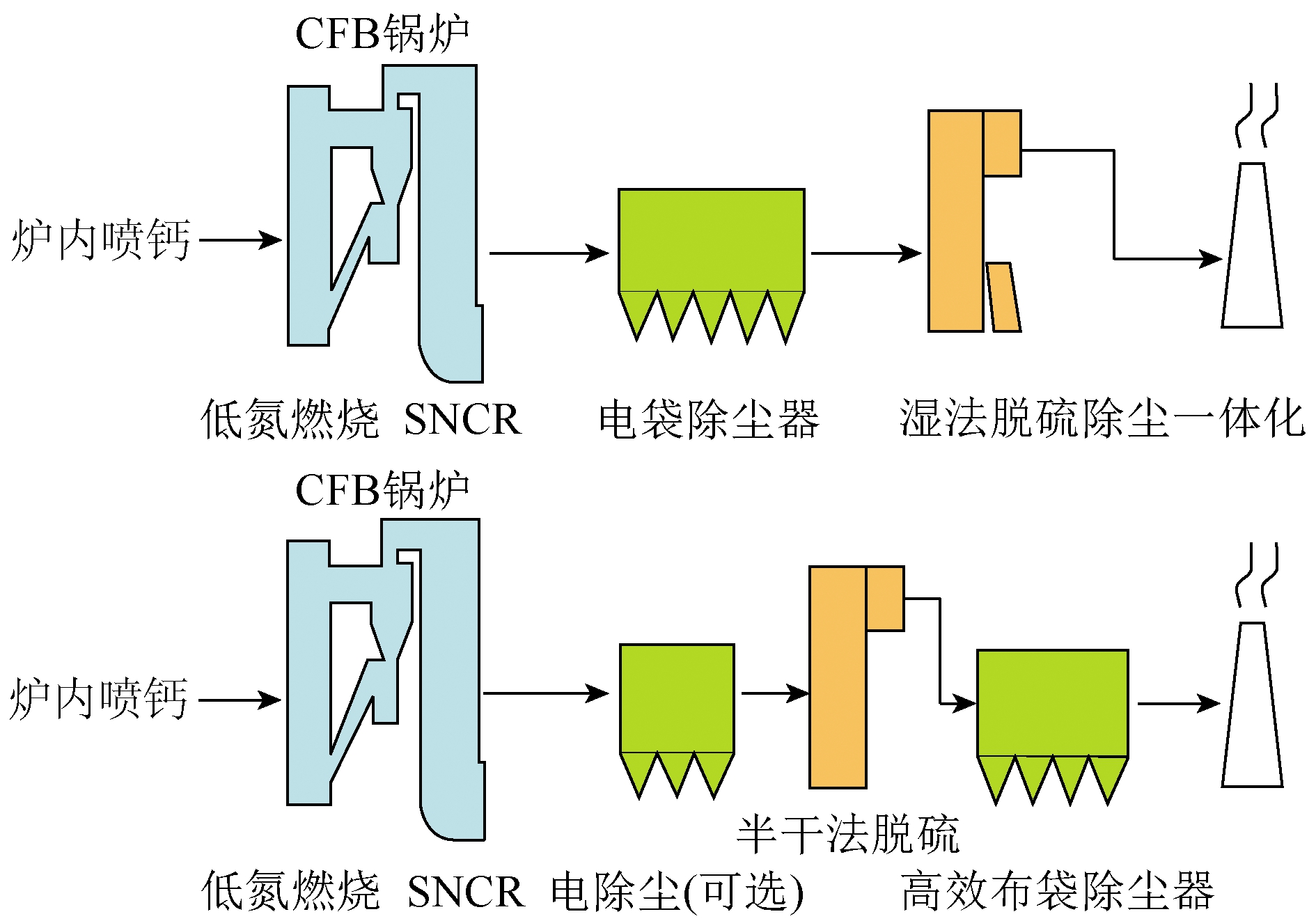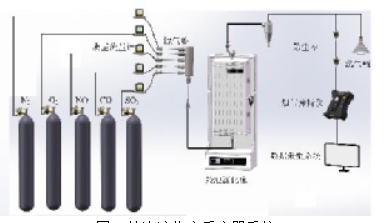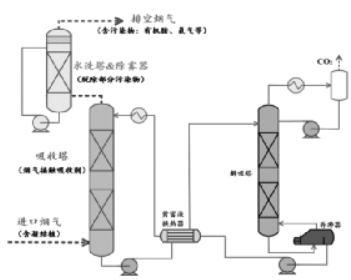研究论文
褐煤及其低温热解半焦中可溶多环芳烃特征
0 引 言
褐煤在全球范围内储量大,分布广,但因高水分、高挥发分、低热值等特性而在传统工业利用中多受限制[1-2]。以褐煤为原料,低温热解(<600 ℃)生产的半焦具有高固定碳、高反应活性等特点,在工业生产中被广泛用作高炉喷吹燃料、冶金还原剂、电石生产原料等[3-5]。另外,半焦因其燃烧反应性及燃尽率高于褐煤,且燃烧排放的颗粒物、气体污染物等显著降低,已被提倡并推广用作清洁民用燃料[6-8]。因此,在全球能源需求和节能减排要求逐渐提高的背景下,褐煤低温热解过程及产出的半焦受广泛关注[9-10]。
多环芳烃(PAHs)是环境介质中普遍存在的一类有机污染物,因致癌、致畸变的潜在风险被广泛关注[11-13]。煤作为一种有机可燃沉积岩,不仅本身含有丰富的可溶PAHs,在热解和不完全燃烧等过程中也生成大量PAHs并释放[14-15]。目前有关煤热解过程生成PAHs的研究,主要聚焦在气态、液态产物中PAHs含量及组成特征方面。DONG等[16-17]采用PY-GC/MS在线分析煤热解释放PAHs随热解温度的变化,结果表明PAHs释放量随温度的升高先增后降,800 ℃热解时释放量最高。YAN等[18]和GAO等[19]对不同煤阶煤热解释放PAHs的研究显示,烟煤热解释放量高于褐煤。LIU等[20]模拟低变质煤层不完全燃烧排放PAHs,发现PAHs排放量随粒径增大而增大。CHEN等[21]、XU等[22]和ZHANG等[23]通过分析低阶煤低温热解生成的气体、焦油中不同类型化合物的分布以及煤/半焦结构特征,探讨了煤热解过程中有机质的演化途径,表明煤结构是影响其热解特性的最重要因素之一,且半焦结构特征对揭示热解机制有重要意义。然而,半焦的结构特征研究主要是对芳香度、碳类型及官能团特征等进行表征[24-26],可溶PAHs作为其有机质组成的一部分尚未见研究报道。而从煤热解过程中生成PAHs的角度来说,不仅包括气态或液态产物中的PAHs,残留于半焦中的可溶PAHs也是不能忽视的一部分。
另外,现有对原煤中可溶PAHs和热解释放PAHs的研究多数局限于US EPA规定的16种优控母体PAHs(16PAHs),涉及烷基取代多环芳烃(aPAHs)、含杂原子PAHs的研究较少[16-17,19,27]。然而,PAHs是否有烷基侧链、侧链尺寸及取代位置都会导致PAHs具有不同的生物活性和反应性[28]。研究表明,aPAHs比母体PAHs的生物毒性更大,环境持久性更强,更应引起重视[29-30]。以3个不同来源褐煤及其550 ℃热解半焦为样本,对其可溶PAHs(包括16PAH、aPAHs和其他芳香烃)的含量及组成特征进行分析和比较,提高对半焦中可溶PAHs特征的认识,也为褐煤低温热解过程中PAHs的生成研究提供补充数据。
1 材料与方法
1.1 材料
3个褐煤样品分别来自内蒙古上海庙矿(SHM-0)、印度尼西亚(YN-0)、蒙古国(WM-0)。3个褐煤分别在550 ℃下热解产出的半焦为SHM-1、YN-1和WM-1。所有样品的工业分析和元素分析结果见表1。
表1 样品的工业分析及元素分析结果
Table 1 Proximate and ultimate analysis of samples

注:*由差减法获得。
热解半焦的制备:管式炉热解试验装置主要包括管式电阻炉(炉膛加热区尺寸φ 60 mm×600 mm)、不锈钢高温反应管(尺寸φ 50 cm×600 cm),温度控制仪及热电偶,冷凝与净化装置等。将100 g煤样(<0.2 mm)放入反应管并置于管式炉,插入热电偶后用法兰隔绝空气;以5 ℃/min升温速率加热至550 ℃,保温15 min后自然冷却至室温。
1.2 萃取
样品中PAHs的萃取以及GC/MS测试方法,参考文献[31]。步骤如下:称取粒径小于0.2 mm的样品1 g,与适量无水硫酸钠、活化铜片混合后放入10 mL螺口玻璃管中,加入萘-d8标样以及10 mL二氯甲烷,超声萃取5 h。取1.5 mL萃取液离心,然后取1 mL上清液过针式过滤器。滤液中加入适当浓度内标(苊-d10、菲-d10、 -d10、苝-d12)后用正己烷定容至1 mL,待仪器分析。
-d10、苝-d12)后用正己烷定容至1 mL,待仪器分析。
1.3 GC/MS分析
分析仪器为气相色谱/质谱/质谱(GC/MS/MS,Waters Xevo TQGC)联用仪。DB-5MS(30.00 m×0.25 mm×0.25 μm)色谱柱,进样口温度280 ℃,进样体积1 μL,载气为氦气,不分流进样。升温程序:初始70 ℃,保留1 min,15 ℃/min升温至180 ℃,保留2 min,10 ℃/min升温至230 ℃,保留0.5 min,5 ℃/min升温至250 ℃,保留2 min,8 ℃/min升温至300 ℃,保留5 min。质谱条件:EI源,70 eV,离子源温度250 ℃,50~550 aum,全扫模式。
通过Masslynx V4.2软件处理采集数据,采用保留时间并且结合NIST17质谱图库比对方法对PAHs进行定性分析,内标法进行定量。烷基取代多环芳烃的定量方法参考其母体多环芳烃。空白试验中未检测出PAHs。萘-d8的回收率在67%~78%。
2 结果与讨论
不同褐煤及其热解半焦的可溶PAHs质量分数见表2。3个褐煤PAHs总量在4 362~125 635 ng/g,其中SHM-0含量最高,YN-0含量最低。3个热解半焦PAHs总量在4 679~10 289 ng/g,YN-1含量最高,SHM-1含量最低。WM-0和WM-1的PAHs总量接近,分别为5 773和5 440 ng/g。3个褐煤中的PAHs除常规母体16PAHs及其对应的aPAHs外,部分样品还检出联苯、苯基萘、二苯并呋喃、二苯并噻吩等化合物如图1所示。
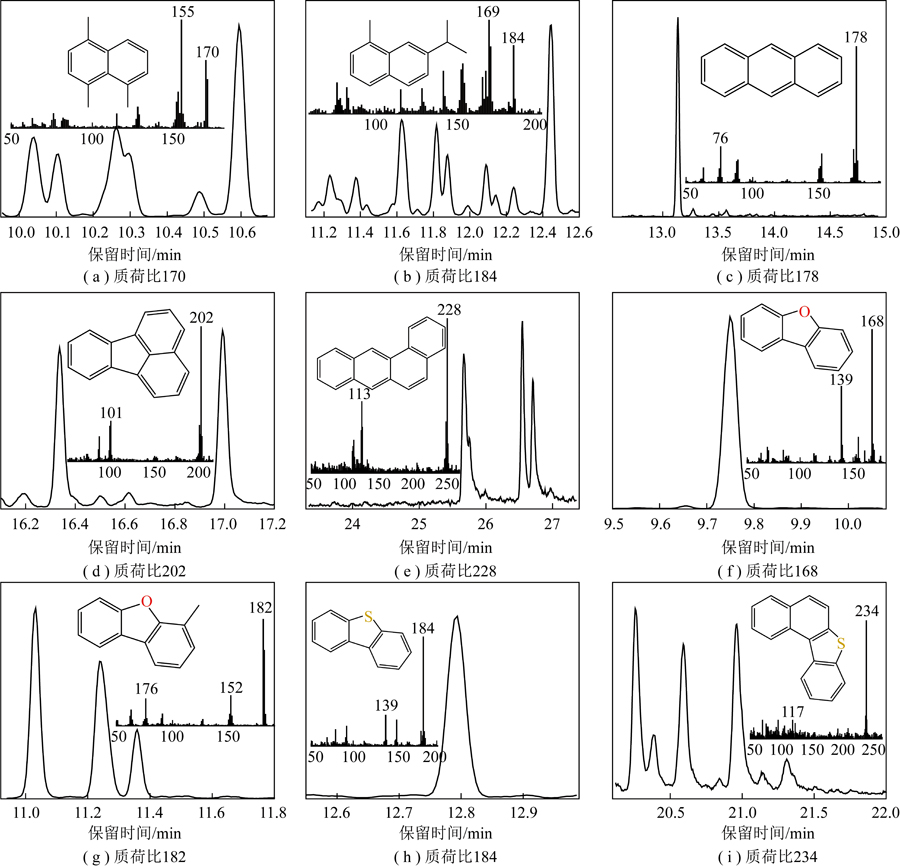
图1 样品中部分PAHs的质量色谱图及质谱图
Fig.1 Mass ion mass spectra and chromatograms of some PAHs in the samples
表2 褐煤及其半焦的PAHs质量分数
Table 2 Mass fraction of PAHs in lignite and its semi-coke ng/g
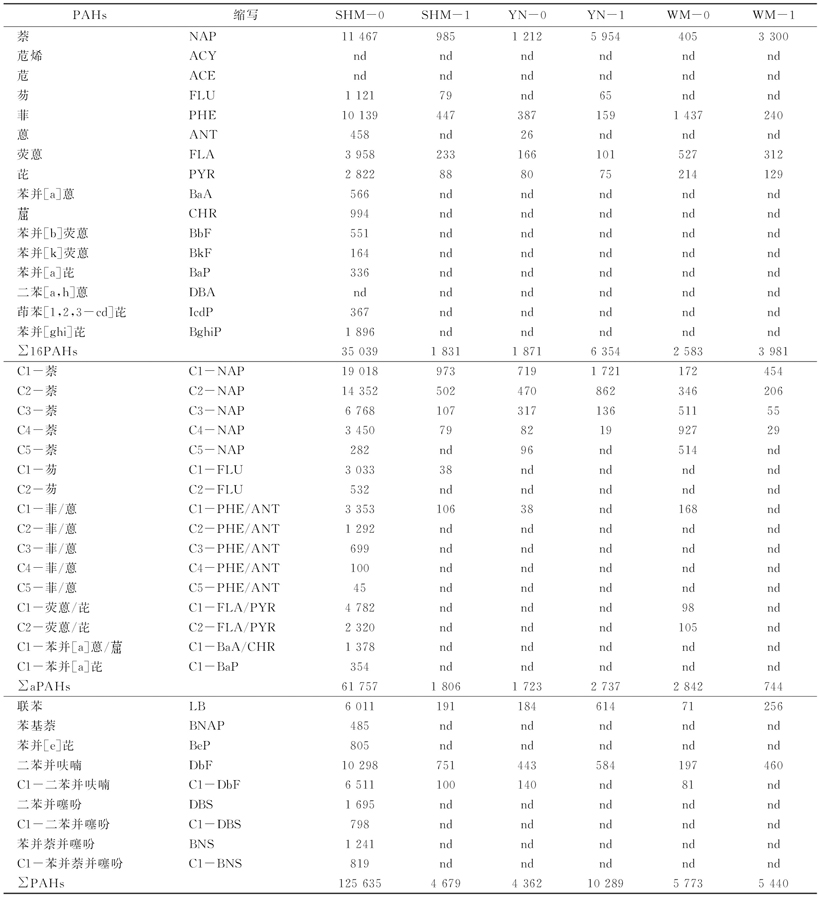
注:nd为未检出。
2.1 16PAHs含量和组成
3个褐煤SHM-0、YN-0和WM-0的母体16PAHs质量分数(∑16PAHs)分别为35 039、1 871、2 583 ng/g(表2)。SHM-0中检出丰富的PAHs,而YN-0和WM-0中PAHs种类较少,苊烯、苊在3个褐煤中均未检出。3个褐煤的16PAHs组成均以2~3环小分子为主,4环次之,分别占∑16PAHs的66.2%~86.9%、13.1%~28.7%(图2)。5~6环大分子PAHs含量在SHM-0的∑16PAHs中约占10.0%,而在YN-0和WM-0中均未检出。前人研究表明,煤中16PAHs含量随煤变质程度的升高而先增后降,烟煤含量最高,褐煤次之,高变质无烟煤含量最低[32-33]。另外,煤源因素如成煤母质、沉积环境等对煤中PAHs含量也有影响[34]。YN-0和WM-0的w(H)/w(C)、w(O)/w(C)相近而高于SHM-0(表1),指示SHM-0的芳构化程度和变质程度稍高于前二者。因此,SHM-0的16PAHs含量高于YN-0和WM-0的结果与文献结论一致。但SHM-0的16PAHs含量相对高出1个数量级的巨大差距,表明煤源因素对PAHs含量的影响比变质程度更大。
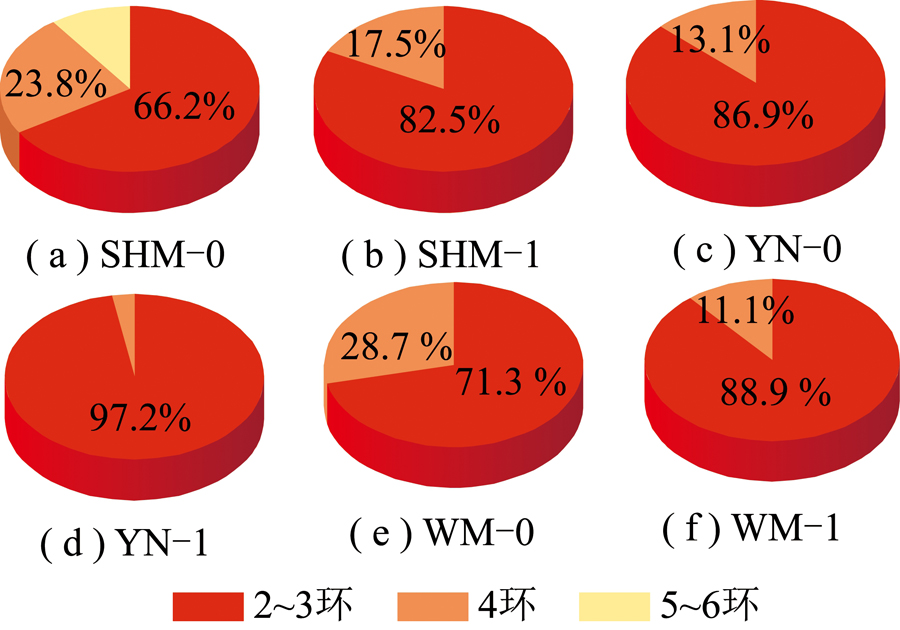
图2 褐煤及其半焦的16PAHs组成
Fig.2 Composition of PAHs in lignites and semi-cokes
热解半焦SHM-1、YN-1、和WM-1的∑16PAHs质量分数分别为1 831、6 354和3 981 ng/g,与WANG等[35]报道的岩浆侵入热变质无烟煤质量分数水平(2 500~5 500 ng/g)几乎相近。3个半焦的16PAHs仍然以2~3环小分子为主,4环次之,分别占∑16PAHs的82.5%~97.2%和2.8%~17.5%。
5~6环大分子PAHs在3个热解半焦中均检出(图2),这与WANG等[35]、LAUMANN等[34]报道的天然焦和受岩浆侵入热变质无烟煤中未检出高环PAHs的结果一致。与原煤的Σ16PAHs含量相比,SHM-1含量显著降低,仅为SHM-0质量分数的5.2%左右;而YN-1和WN-1的Σ16PAHs含量高于原煤,分别约为YN-0和WM-0质量分数的339.6%和154.1%,其中单体萘质量分数的增大是∑16PAHs质量分数增大的主要贡献者。另外,尽管半焦和原煤的16PAHs组成均以小分子为主,但半焦中2~3环PAHs占比高于原煤,4环占比则低于原煤。半焦中PAHs组成向更小分子化过渡,这可能是因为小分子化合物在结构更加致密的半焦中更易被保护。不同褐煤热解产出半焦的16PAHs含量相对于原煤呈不同变化,揭示褐煤低温热解时PAHs的生成与释放过程可能不同。
2.2 aPAHs含量和组成
褐煤SHM-0、YN-0和WM-0的aPAHs总量(∑aPAHs)分别为61 757、17 23和2 842 ng/g。3个褐煤中的aPAHs均以烷基萘为主,占∑aPAHs的71.0%~97.8%,而SHM-0中还有丰富的烷基菲/蒽、烷基荧蒽/芘。SHM-0和WM-0的∑aPAHs含量均高于对应母体∑16PAHs含量,尤其SHM-0的∑aPAHs是∑16PAHs的176.3%。YN-0的∑aPAHs稍低于∑16PAHs(图3)。可知不同来源褐煤中均有aPAHs存在,且含量可能比母体16PAHs更高。
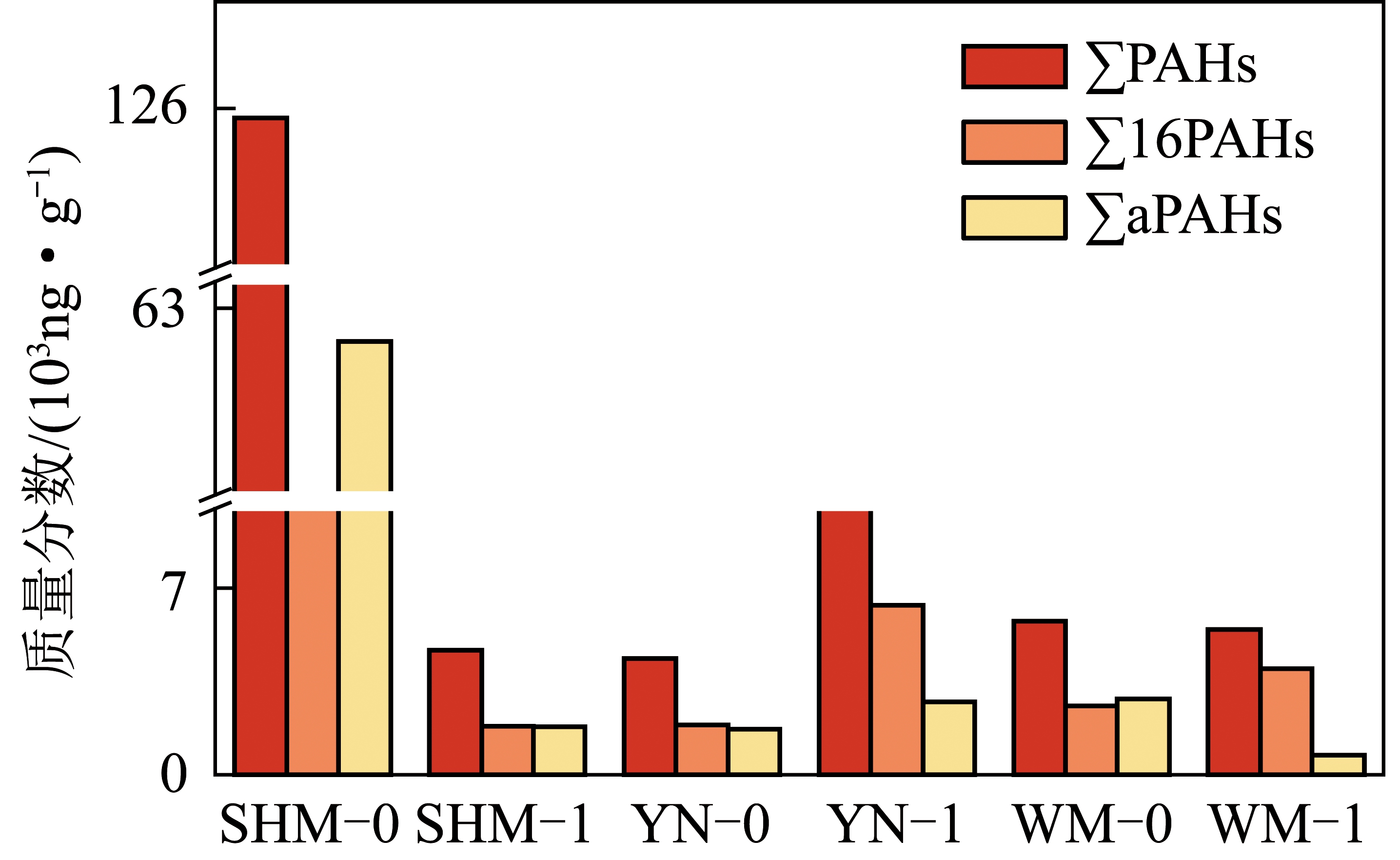
图3 褐煤及其半焦PAHs质量分数
Fig.3 Mass fraction of PAHs in lignites and semi-cokes
半焦SHM-1、YN-1和WM-1的∑aPAHs质量分数分别为1 806、2 737和744 ng/g,均与褐煤一致,以烷基萘为主要组成。3个热解半焦的∑aPAHs含量均低于对应母体∑16PAHs含量,表明存留于半焦的PAHs以热力学更稳定的母体形式为主。与对应褐煤的∑aPAHs 含量相比,SHM-1和WM-1的含量显著降低,分别为SHM-0和WM-0含量的2.9%和26.2%。但YN-1的∑aPAHs含量是YN-0含量的158.8%,其中C1-萘和C2-萘含量的增大是主要贡献。由此可见,aPAHs不仅在褐煤中含量丰富,在热解半焦中也普遍存在,且半焦中aPAHs含量可能比原煤中更高。
另一方面,对于褐煤和半焦中都丰富存在的萘系物(C0-5-NAP),其分布在褐煤SHM-0和WM-0均呈“钟形”成岩源模式,在YN-0褐煤中则呈“斜坡形”热解源分布模式(图4)[36-37]。这表明不同来源褐煤中低环PAHs烷基取代物的分布模式并不相同,且与前人报道的低变质煤中PAHs烷基取代同系物以成岩源模式分布的结论并不完全一致[34-36]。半焦中的萘系物分布均呈热解源模式,这符合PAHs的烷基侧链在热解过程中易断裂的行为,以及母体PAHs相对于aPAHs热力学更稳定的特征。
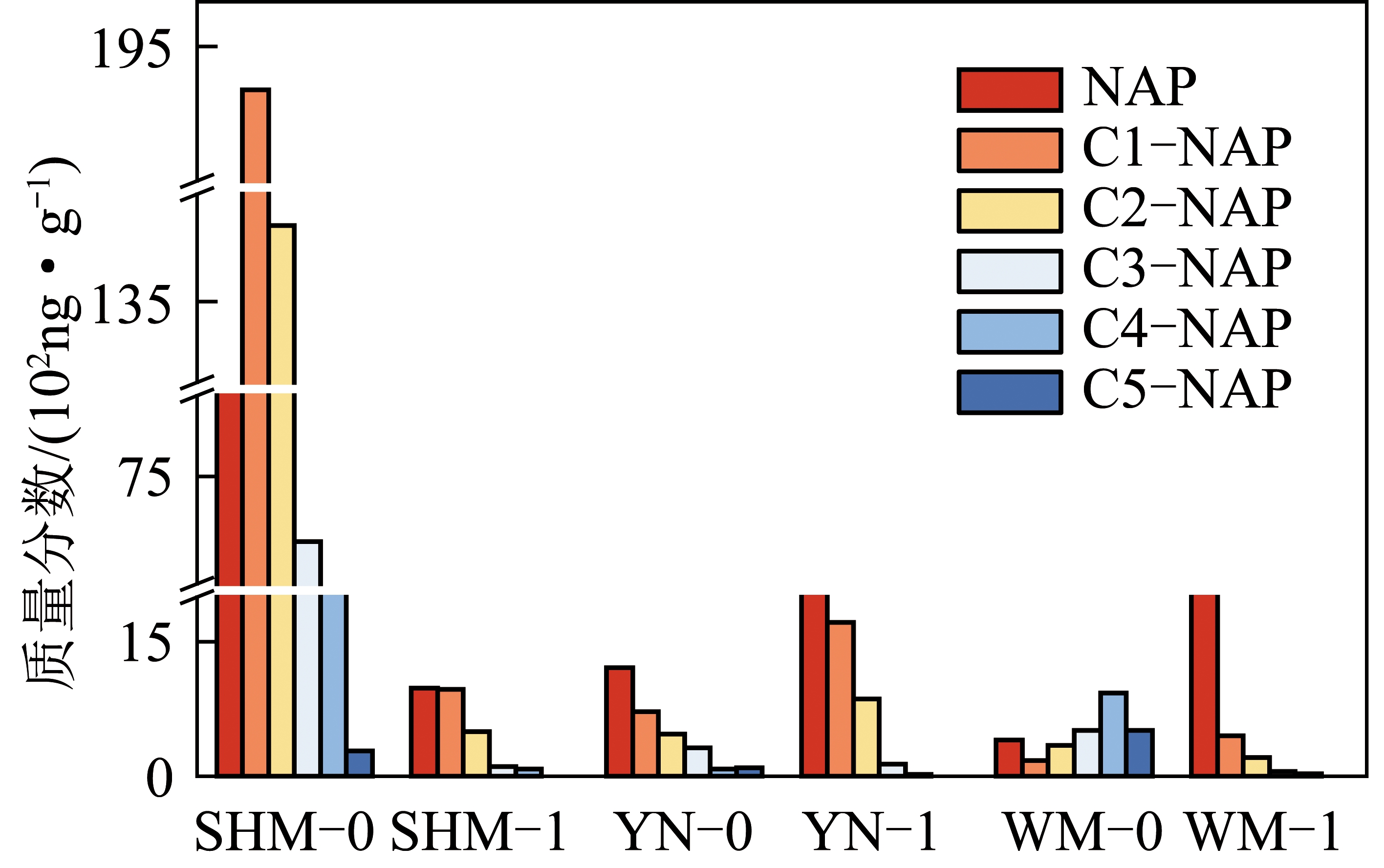
图4 褐煤及其半焦萘及烷基萘分布
Fig.4 Distribution of naphthalene and alkylated naphthalenes in lignites and semi-cokes
2.3 煤热解可溶PAHs变化机理
煤中有机质在热解过程中主要发生裂解和缩合两类化学反应[38-39]。研究表明,煤热解时通过大分子结构的裂解和析出小分子化合物的缩合反应都会形成PAHs,其中600~1 000 ℃是PAHs形成和释放的主要温度区间[19]。低于600 ℃热解时,大分子结构中一些弱桥键(如亚甲基、醚键等)的断裂也会释放少量PAHs[16-17,19-20]。另外,煤中原有的可溶PAHs在热解过程中可能直接挥发释放,也可能裂解为小分子化合物而转化[16]。因此,煤热解后残留于半焦中的可溶PAHs可能有3个来源:① 原煤可溶PAHs挥发或转化后的残留。② 原煤大分子结构中一些弱桥键的断裂产生新的PAHs,这些PAHs有部分被困于半焦而未能释放。这类新生成的PAHs与原煤大分子结构中弱桥键的类型和含量,以及芳香核的尺寸密切相关。③ 析出的一些小分子化合物或自由基碎片可能相互缩合形成PAHs并再次沉积在固体表面。
LIN等[40]对印尼褐煤结构特征的研究表明,其大分子结构的缩合程度较低,芳香核主要是通过脂肪环或桥键连接的苯和萘结构,无3环或以上芳香碳存在。因此,推测YN-0褐煤在550 ℃低温热解过程中因桥键的断裂而释放出大量苯环或萘环结构的芳香核,不稳定的芳香核与裂解产生的自由基碎片结合形成大量单环或双环芳香化合物。这可能是YN-1半焦中PAHs尤其萘和烷基萘含量显著高于原煤的主要原因。
SHM-0褐煤PAHs含量显著高于YN-0和WM-0,且在SHM-0中检出另2种褐煤中未检出的5~6环高分子PAHs(如苯并荧蒽、苯并[ghi]苝等),从分子层面指示SHM-0褐煤的芳香度相对较高。再结合SHM-0中w(H)/w(C)和w(O)/w(C)相对较低,推测SHM-0比YN-0和WM-0的大分子结构相对致密,芳香核的环尺寸相对偏大。因此,SHM-0在热解过程中发生的大分子结构裂解相对于YN-0可能非常有限。而半焦SHM-1的PAHs含量相对原煤显著降低的主要原因,可能是原有可溶PAHs大量挥发释放。WM-0煤的w(H)/w(C)和w(O)/w(C)与YN-0接近,但大分子结构中连接芳香核的氧醚键等弱桥键可能相对偏少(WM-0的氧含量低于YN-0)。且半焦WM-1中萘及烷基萘含量显著高于原煤,这与YN-1半焦的PAHs含量增大主要是萘系物的贡献一致,反映WM-0的大分子芳香核组成可能与YN-0相似,以低环为主,并在热解过程中通过裂解反应生成大量小分子PAHs。综上所述,煤大分子结构特征的差异可能是褐煤热解半焦PAHs含量相对原煤变化不同的主要原因。在对煤热解尤其是低温热解时PAHs生成及煤结构演化特征研究中,不能只以释放气态PAHs或液态焦油中的芳香化合物为目标,还应考虑存留于半焦中的可溶PAHs。
另外,从清洁燃料角度来说,不仅要考虑热解过程释放PAHs造成的环境污染,还应考虑煤/焦在运输、储存等过程中通过碎屑、颗粒等形态向环境介质逸散而传输的PAHs[13]。低温热解过程能明确降低褐煤的水分、挥发分等,但可溶PAHs含量变化不确定。如本研究YN-1半焦的PAHs含量显著高于原煤,半焦带来的环境PAHs污染可能比原煤严重。因此,建议半焦可溶PAHs含量也应纳入半焦质量的考察,并通过调整热解工艺条件优化。
3 结 论
1)对3个不同褐煤及其550 ℃热解半焦中可溶PAHs进行测定。不同来源褐煤中可溶PAHs含量差异显著,但都表现出aPAHs含量丰富的特征。半焦中的PAHs以母体形式为主,但aPAHs仍普遍存在。
2)不同半焦的PAHs含量相对于原煤呈不同变化,SHM-1的PAHs含量低于原煤,YN-1含量则高于原煤,而WM-1含量与原煤相近。褐煤和半焦中PAHs均以萘及烷基萘为主,且YN-1和WM-1半焦中萘和烷基萘含量相对原煤显著增大,揭示热解过程中通过裂解反应有大量小分子PAHs生成。
3)煤/焦中可溶PAHs含量及组成受煤变质程度、煤源因素影响,也是其结构特征的一种体现。半焦中可溶PAHs含量及组成是煤热解过程中生成PAHs的不可忽视的一部分,可为PAHs生成机制及煤结构演化途径研究提供有效信息。
[1]  D,
D,  KOBALJ P, et al. An initial study on feasible treatment of Serbian lignite through utilization of low-rank coal upgrading technologies [J]. Chemical Engineering Research and Design, 2014, 92(11): 2383-2395.
KOBALJ P, et al. An initial study on feasible treatment of Serbian lignite through utilization of low-rank coal upgrading technologies [J]. Chemical Engineering Research and Design, 2014, 92(11): 2383-2395.
[2] HE Q, WAN K, HOADLEY A, et al. TG-GC-MS study of volatile products from Shengli lignite pyrolysis [J]. Fuel, 2015, 156: 121-128.
[3] 马宝岐, 罗雄威. 我国半焦产业发展趋势及建议[J]. 煤炭加工与综合利用, 2014(4): 22-26.
MA Baoqi,LUO Xiongwei. China′s semi-coke industry development trend and suggestions [J]. Coal Processing &Comprehensive Utilization,2014(4): 22-26.
[4] 赵玉良, 葛延, 马玄恒, 等. 小颗粒煤半焦的应用分析及展望[J]. 煤炭加工与综合利用, 2017(6):7-12.
ZHAO Yuliang,GE Yan,MA Xuanheng,et al.Application analysis and prospect of small particle coal semi-coke [J].Coal Processing &Comprehensive Utilization,2017(6):7-12.
[5] 郑少伟, 王志强, 王鹏, 等. 热解半焦的清洁高效利用现状及研究进展[J]. 华电技术, 2020, 42(7): 42-49.
ZHENG Shaowei,WANG Zhiqiang,WANG Peng, et al. Current status and progress of the clean and efficient utilization of pyrolysis semi-coke [J]. Huadian Technology,2020,42(7): 42-49.
[6] 张鑫. 兰炭替代无烟煤高效清洁利用的研究[J]. 洁净煤技术, 2015,21(3): 103-106.
ZHANG Xin.Feasibility on semicoke substitute for anthracite in energy conservation and emissions reduction [J].Clean Coal Technology,2015,21(3):103-106.
[7] 侯吉礼, 尚文智, 刘军利, 等. 兰炭(半焦)替代原煤清洁燃烧的排放对比研究[J]. 煤炭技术, 2016, 35(8): 287-289.
HOU Jili,SHANG Wenzhi,LIU Junli,et al.Comparison of emission from Lantan (Semi-coke) instead of raw coal for clean and efficient combustion [J].Coal Technology,2016,35(8):287-289.
[8] 刘军利, 王玉飞, 闫龙, 等. 兰炭与不同煤种燃烧时污染物排放量对比研究[J]. 煤炭加工与综合利用, 2021(12): 58-62.
LIU Junli,WANG Yufei,YAN Long,et al.Comparative study on pollutant emission of semi-coke and different coals during combustion [J].Coal Processing &Comprehensive Utilization,2021(12):58-62.
[9] REDDY B R, VINU R. Microwave assisted pyrolysis of Indian and Indonesian coals and product characterization [J]. Fuel Processing Technology, 2016, 154: 96-103.
[10] LI Y L, HUANG S L, WU Y, et al. The roles of the low molecular weight compounds in the low-temperature pyrolysis of low-rank coal [J]. Journal of the Energy Institute, 2019, 92(2): 203-209.
[11] LIANG M, LIANG Y, LIANG H, et al. Polycyclic aromatic hydrocarbons in soil of the backfilled region in the Wuda coal fire area, Inner Mongolia, China [J]. Ecotoxicology and Environmental Safety, 2018, 165: 434-439.
[12] LIANG M, LIANG H, RAO Z, et al. Characterization of polycyclic aromatic hydrocarbons in urban-rural integration area soil, North China: Spatial distribution, sources and potential human health risk assessment [J]. Chemosphere, 2019, 234: 875-884.
[13] LIANG M, LIANG H, RAO Z, et al. Occurrence of polycyclic aromatic hydrocarbons in groundwater from rural areas in eastern China: Spatial distribution, source apportionment and health cancer risk assessment [J]. Chemosphere, 2020, 259: 127534.
[14] ACHTEN C, HOFMANN T. Native polycyclic aromatic hydrocarbons (PAH) in coals:A hardly recognized source of environmental contamination [J]. Science of the Total Environment, 2009, 407(8): 2461-2473.
[15] GENG C, CHEN J, YANG X, et al. Emission factors of polycyclic aromatic hydrocarbons from domestic coal combustion in China [J]. Journal of Environmental Sciences, 2014, 26(1): 160-166.
[16] DONG J, LI F, XIE K. Study on the source of polycyclic ar-omatic hydrocarbons (PAHs) during coal pyrolysis by PY-GC-MS [J]. Journal of Hazardous Materials, 2012, 243: 80-85.
[17] DONG J, CHENG Z, LI F. PAHs emission from the pyrolysis of Western Chinese coal [J]. Journal of Analytical and Applied Pyrolysis, 2013, 104: 502-507.
[18] YAN L, BAI Y, ZHAO R, et al. Correlation between coal structure and release of the two organic compounds during pyrolysis [J]. Fuel, 2015, 145: 12-17.
[19] GAO M, WANG Y, DONG J, et al. Release behavior and formation mechanism of polycyclic aromatic hydrocarbons during coal pyrolysis [J]. Chemosphere, 2016, 158: 1-8.
[20] LIU S, WANG C, ZHANG S, et al. Formation and distribution of polycyclic aromatic hydrocarbons (PAHs) derived from coal seam combustion: A case study of the Ulanqab lignite from Inner Mongolia, Northern China [J]. International Journal of Coal Geology, 2012, 90/91: 126-134.
[21] CHEN Y, SU S, ZHANG L, et al. Insights into evolution mechanism of PAHs in coal thermal conversion: A combined experimental and DFT study [J]. Energy, 2021, 222: 119970.
[22] XU K, HU S, WANG Y, et al. Relation between char structures and formation of volatiles during the pyrolysis of Shenfu coal: Further understanding on the effects of mobile phase and fixed phase [J]. Fuel Processing Technology, 2018, 178: 379-385.
[23] ZHANG L, HU S, XU K, et al. Study on the structural evolution of semi-chars and their solvent extracted materials during pyrolysis process of a Chinese low-rank coal [J]. Fuel, 2018, 214: 363-368.
[24] 邹达, 白翔, 李显, 等. 新疆和丰煤分段热解过程中产物组成的演变规律[J]. 煤炭学报, 2018, 43(3): 846-854.
ZOU Da,BAI Xiang,LI Xian,et al.Composition and structure evolution characteristics of product from segmenting pyrolysis of Xinjiang Hefeng coal [J].Journal of China Coal Society,2018,43(3):846-856.
[25] 任磊, 杨凤玲, 贾阳杰, 等. 低阶煤热解条件对气相产物分布和半焦结构的影响[J]. 煤炭转化, 2019, 42(6): 17-27.
REN Lei,YANG Fenglin,JIA Yangjie,et al.Effect of conditions of low-rank coal pyrolysis on gas phase product distribution and semi-coke structure [J].Coal Conversion,2019,42(6):17-27.
[26] 刘涛, 苏胜, 何立模, 等. 煤热解半焦结构及其对制备型煤成型特性的影响[J]. 煤炭转化, 2021, 44(2): 1-8.
LIU Tao,SU Sheng,HE Limo,et al. Structure of semi-coke obtained from coal pyrolysis and its influence on properties of briquette [J]. Coal Conversion,2021, 44(2): 1-8.
[27] WANG R, LIU G, ZHANG J, et al. Abundances of polycyclic aromatic hydrocarbons (PAHs) in 14 Chinese and American coals and their relation to coal rank and weathering [J]. Energy &Fuels, 2010, 24(11): 6061-6066.
[28] WORMAT M J, DAROFIM A F, LONGWELL J P. Changes in the degree of substitution of polycyclic aromatic compounds from pyrolysis of a high-volatile bituminous coal[J]. Energy &Fuels,1987,1:431-437.
[29] 孙溶, 陈颖军, 韩勇, 等. 典型烟煤中游离态母体及烷基多环芳烃的含量和组成特征[J]. 地球化学, 2017, 46(4): 358-366.
SUN Rong,CHEN Yingjun,HAN Yong,et al.The concentration and composition characteristics of soluble parent and alkylated polycyclic aromatic hydrocarbons in typical bituminous coals [J].Geochimica,2017,46(4):358-366.
[30] 陈雪, 许丹丹, 钱雅慧, 等. 淮北刘桥二矿煤矸石多环芳烃污染特征及毒性评价 [J]. 中国环境科学, 2022,42(2): 1-11.
CHEN Xue,XU Dandan,QIAN Yahui,et al.Pollution characteristics and toxicity assessment of pahs in coal gangue from liuqiao mine in Huaibei [J]. China Environmental Science,2022,42(2): 1-11.
[31] 钱雅慧, 汪婷, 洪秀萍, 等. 煤矿区地表土中烷基多环芳烃的定量方法研究[J]. 质谱学报, 2022,43(2): 1-11.
QIAN Yahui,WANG Ting,HONG Xiuping,et al. Study on quantitative method of alkyl polycyclic aromatic hydrocarbons in surface soils of coal mines [J].Jourmal of Chinese Mass Spectrometry Society,2022,43(2):1-11.
[32] 刘淑琴, 王媛媛, 张尚军, 等. 四种低阶煤中多环芳烃的分布特征[J]. 煤炭科学技术, 2010, 38(11): 120-124.
LIU Shuqin,WANG Yuanyuan,ZHANG Shangjun,et al. Distribution features of polycyclic aromatic hydtocarbons in four different low rank coals [J].Coal Science and Tenchnology,2010,38(11): 120-124.
[33] 刘志华, 刘大锰, 姚艳斌. 煤中多环芳烃分布赋存规律研究[J]. 煤炭科学技术, 2010, 38(2): 113-116.
LIU Zhihua,LIU Dameng,YAO Yanbing,et al.Study on distribution and deposit law of polycyclic aromatic hydrocarbon in coal [J]. Coal Science and Tenchnology,2010,38(2): 113-116.
[34] LAUMANN S, ![]() V, KRUGE M A, et al. Variations in concentrations and compositions of polycyclic aromatic hydrocarbons (PAHs) in coals related to the coal rank and origin [J]. Environmental Pollution, 2011, 159(10): 2690-2697.
V, KRUGE M A, et al. Variations in concentrations and compositions of polycyclic aromatic hydrocarbons (PAHs) in coals related to the coal rank and origin [J]. Environmental Pollution, 2011, 159(10): 2690-2697.
[35] WANG R, LIU G. Variations of concentration and composition of polycyclic aromatic hydrocarbons in coals in response to dike intrusion in the Huainan coalfield in eastern China [J]. Organic Geochemistry, 2015, 83/84: 202-214.
[36] STOUT S A, EMSBO-MATTINGLY S D. Concentration and cha-racter of PAHs and other hydrocarbons in coals of varying rank:Implications for environmental studies of soils and sediments containing particulate coal [J]. Organic Geochemistry, 2008, 39(7): 801-819.
[37] GOLZADEH N, BARST B D, BAKER J M, et al. Alkylated polycyclic aromatic hydrocarbons are the largest contributor to polycyclic aromatic compound concentrations in traditional foods of the Bigstone Cree Nation in Alberta, Canada [J]. Environmental Pollution, 2021, 275: 116625.
[38] LIN X, LUO M, LI S, et al. The evolutionary route of coal matrix during integrated cascade pyrolysis of a typical low-rank coal [J]. Applied Energy, 2017, 199: 335-346.
[39] XU K, HU S, ZHANG L, et al. Effect of temperature on Shenfu coal pyrolysis process related to its chemical structure transformation[J]. Fuel Processing Technology, 2021, 213: 106662.
[40] LIN H, LI K, ZHANG X, et al. Structure characterization and model construction of indonesian brown coal [J]. Energy &Fuels, 2016, 30(5): 3809-3814.
Characterization of soluble polycyclic aromatic hydrocarbons in lignite and its low-temperature pyrolysis semi-coke

LU Mengqian,LI Shan,SHI Yungu,et al.Characterization of soluble polycyclic aromatic hydrocarbons in lignite and its low-temperature pyrolysis semi-coke[J].Clean Coal Technology,2023,29(11):58-65.






